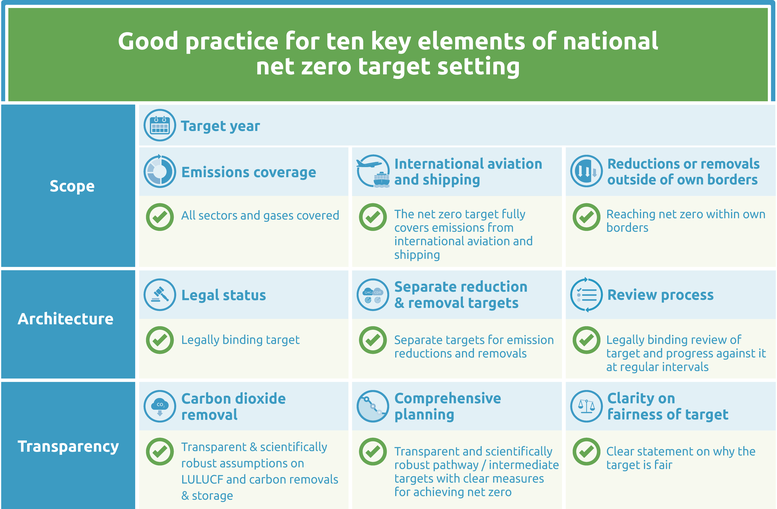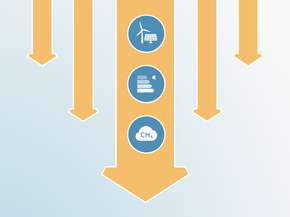Net zero targets
Summary
We evaluate the net zero target as: Average
Ethiopia has not yet passed its net zero target in law but stated its ambition to reach net zero by 2050. This ambition includes three net zero scenarios in its Long-Term Low Emission and Climate Resilient Development Strategy (2020-2050), which was submitted to the UNFCCC in June 2023.
While Ethiopia has not yet formally committed to a specific pathway for achieving net zero, the LT-LEDS develops three scenarios that could lead to net zero by 2050 or sooner. Two of the scenarios, namely the ‘NDC-aligned’ and ‘Late Action’ scenarios, aim to reach negative emissions in 2050, while the ‘Maximum Ambition’ scenario projects net zero emissions by 2035. Ethiopia considers the NDC-aligned scenario to be the most plausible pathway for achieving both its net zero target by 2050 and meeting its NDC targets.
The LT-LEDS includes details on sectoral interventions and provides sectoral emissions pathways for the three scenarios for energy, transport, agriculture and industry. While pathways are also provided for the forestry and waste sectors, the LT-LEDS could be improved by providing more clarity and contextual details on the emissions pathways for these sectors.
Ethiopia could further advance its net zero target’s transparency, target architecture, and scope by enshrining its net zero target in law, providing information on whether its targets cover international aviation and shipping, and communicate transparent assumptions on carbon dioxide removals pathways.
CAT analysis of net zero target
CAT analysis of net zero target
Scope
- Target year – Ethiopia has developed two scenarios to achieve net zero by 2050 and a more ambitious scenario aiming for net zero by 2035 in its Long-Term Low Emission and Climate Resilient Development Strategy (LT-LEDS). Ethiopia plans to achieve net zero by 2050 at the latest.
- Emissions coverage – The target covers all GHG emissions (i.e., the 7 Kyoto gases: CO2, CH4, N2O, HFCs, PFCs, SF6, NF3) and all sectors of the economy (excluding international bunkers).
- International aviation and shipping – Ethiopia does not provide specific information on its intention to include international aviation and shipping in its net zero target. However, it mentions the use of biofuels in aviation as one of the strategic actions in its LT-LEDS.
- Reductions or removals outside of own borders – Ethiopia’s LT-LEDS does not specify the extent of removals outside of its own borders or if it relies on international carbon credits. Therefore, interventions are assumed to be within its own borders. Ethiopia’s LT-LEDS does seem to imply that it intends to sell carbon credits. The CAT finds a very narrow scope, if at all, for countries to sell or transfer emissions reductions they may have achieved as the Paris Agreement foresees ambitious mitigation efforts progressively increasing in all countries in line with the 1.5°C limit.
Target architecture
- Legal status – Ethiopia has not yet enshrined its net zero target into law domestically, but it has expressed its ambition to reach net zero by 2050. This ambition is outlined in three net zero scenarios in its LT-LEDS which submitted to the UNFCCC in June 2023.
- Separate reduction & removal targets – Ethiopia outlines a decarbonisation pathway for intervention actions from 2020 to 2050, consisting of three main actions: reduced deforestation, afforestation and reforestation, and forest restoration targets. Each of these actions has its own cumulative reduction and removal targets.
- Review process – Ethiopia has a non-legally binding process in place to review the LT-LEDS (The Federal Democratic Republic of Ethiopia, 2023). The Ministry of Planning and Development is responsible for Ethiopia’s LT-LEDS Monitoring, Reporting, and Verification and Monitoring and Evaluation, which will be improved through NDC revision cycles.
Transparency
- Carbon dioxide removal – Ethiopia plans to use the LULUCF sector as a net carbon sink by 2050, but does not plan to use other types of carbon dioxide removal (CDR). While the LT-LEDS stated cumulative carbon dioxide reductions/removals, there is a lack of clarity regarding the pathway figures and the annual amounts of removal.
- Comprehensive planning – The LT-LEDS develops scenarios that could lead to net zero by 2050 or sooner, but Ethiopia has not yet formally committed to a specific pathway. Ethiopia considers the NDC-aligned scenario to be the most plausible pathway for achieving its net zero target by 2050 and meeting its NDC targets along the way.
- Clarity on fairness of target – Ethiopia considers that the updated emission reduction targets in its LT-LEDS reflect the highest possible ambition given the national circumstances, representing a fair contribution to the long-term global mitigation goal. Ethiopia also states that it cannot achieve its net zero target with only its own resources and would need support through international climate finance.
Good practice
The Climate Action Tracker has defined the following good practice for all ten key elements of net zero targets. Countries can refer to this good practice to design or enhance their net zero targets.
Further analysis
Latest publications
Stay informed
Subscribe to our newsletter





